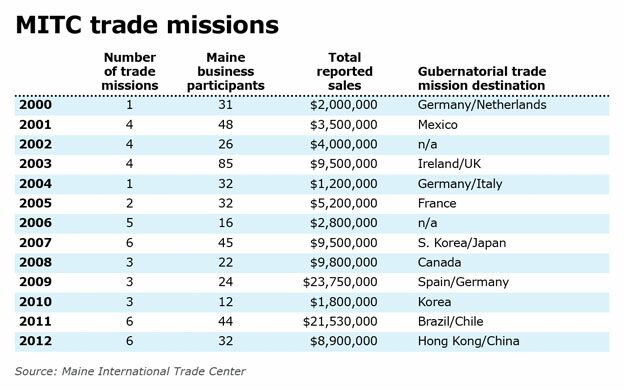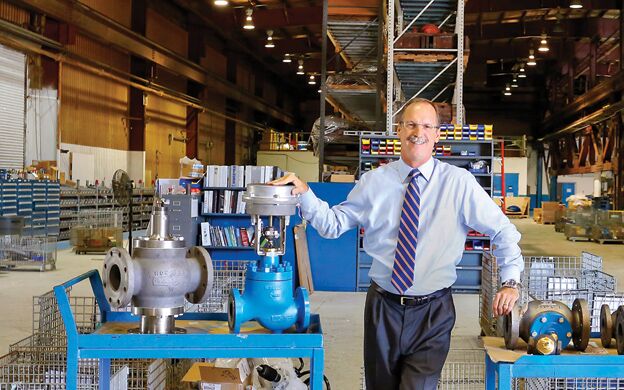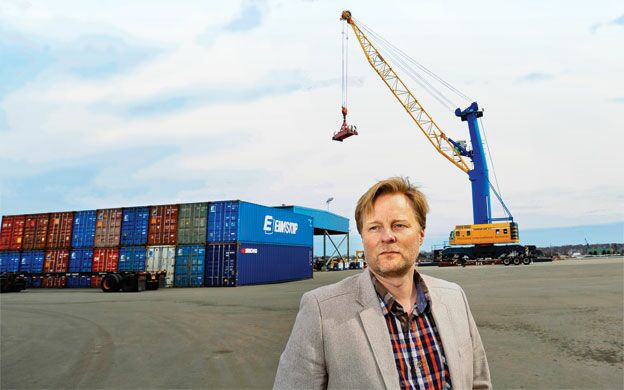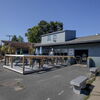Are Maine's overseas trade missions worth the time and money?
When Gov. Paul LePage leads a delegation of Maine business owners and leaders to the United Kingdom and Iceland in June, it will mark the 17th year for business-to-business meetings across the globe organized by the Maine International Trade Center, based in Portland.
In a surprisingly short time, these international trade missions have become a fixture of Maine's economic landscape, a concept that would have seemed outlandish as recently as the 1960s, when Maine-based trade was usually conducted only with other states and eastern Canada, not countries halfway across the globe.
While now well-established, the question often arises of how much is accomplished through MITC and its various programs, particularly the trade missions. Is it worth the time of the governor or business leaders?
There's no definitive report card for such state programs. As measured by sales, the trade missions have clearly grown over time, although the year-to-year totals vary widely. MITC President Janine Cary says that some missions lend themselves to large sales volumes — those involving the pulp and paper industry, for instance — while others attract mainly small companies with smaller sales volumes, such as missions focused on biotech or health product companies. “That's not the only measurement we use, but it is an important benchmark,” she says.
For the four years from 2009–12, for instance, reported sales volumes totaled $55.9 million, or $14 million a year. That's a three-fold increase from the four years from 2000–03, when sales volumes were $19 million, or $4.7 million a year.
Figures aren't yet in for the November 2013 mission to Mexico and Colombia, but Cary said it was among the more successful ventures in terms of sales.
The number of participants also varies, depending on the countries being visited and, apparently, the state of the economy. The largest number of participating businesses to date came in 2003, when 85 businesses went on a trip to Ireland and the U.K. The lowest attendance came in 2010 on a mission to South Korea, when only 12 businesses participated, though the following year 44 joined the trip to Brazil and Chile. So far, 29 are registered for the U.K.-Iceland trip.
Tracked by destination over the years, the new or emerging markets for Maine are located in Europe, particularly the British Isles, and in East Asia and South America.
Leveraging visits
The value of the trade missions goes beyond what can be easily quantified. While the primary focus is still exports, John Wolanski, vice president of sales and marketing of GAC Chemical in Searsport, who was on last fall's trip to Mexico and serves as vice president of the MITC board, said that joint ventures are becoming increasingly common.
Over the last few years, GAC Chemical has built a relationship with Dalegip, a Mexican company that, like GAC, was originally built on sales to the paper industry. Dalegip, in fact, is the dominant player in Mexico, controlling about 80% of the paper industry market. Its attempts to gain access to the North American market, however, were deterred by high transportation costs and other barriers.
The answer was a joint venture, which has made Dalegip “the first direct Mexican investor in the Maine economy,” as Wolanski puts it. The company spent last year ramping up a satellite facility in Searsport, with Dalegip engineers and managers playing the lead roles.
The new plant went on line in January, and once things are running smoothly, GAC Chemical will use its own employees to manufacture products under contract to Dalegip. “It's a true partnership that benefits both companies,” Wolanski says.
While Maine saw most of its textile and shoe businesses depart for southern destinations a generation or two ago, Wolanski says conditions now favor Maine as a site for increased manufacturing in the years ahead.
Last November in Mexico City, about 90 people attended a reception hosted by GAC Chemical that attracted several Mexican businesses from Queretaro, a state about two hours north of the capital that's emerging as a major manufacturing center.
Wolanski says that once more Mexican companies learn about the successful project with Dalegip, some will want to explore opportunities to invest in Maine. “The seed was planted, and we hope it will take root,” he says.
Vital connections
MITC and its programs have enjoyed unusual stability across three administrations marked by strikingly different priorities, those of Independent Angus King, Democrat John Baldacci, and LePage, a Republican. Each has taken a personal role in the success of each mission, and while the results have varied from year to year, all three governors have spoken in support of MITC as providing vital connections to the wider world for business in a small, mostly rural state.
The stability starts with the staff. Cary came on as vice president in 2000 and was promoted to president in 2006. Under her leadership, MITC has carved out a different niche from the larger offices maintained by many other states.
What's unusual about MITC is that it emphasizes business-to-business contacts, with the governor playing a supporting role, rather than the government-to-government meetings that larger states tend to prefer.
“This is about serving Maine businesses, and helping them make the contacts they need to grow,” Cary said. “That's really our one and only purpose, and it gives us a strong focus.”
There's a lot more to MITC programs than the gubernatorial trade missions, though those are certainly the year's highlight. In addition, there are three or four other smaller meetings for specific business sectors, plus outreach events like the annual Trade Day, this year held at the Cross Insurance Center in Bangor May 15 highlighting “The New North.” It will be followed by the trade mission on the same theme June 8–14, with visits to London and Cambridge, England, and Reykjavik, Iceland.
What's also unusual about the international trade program is the close and friendly working relations between state and federal agencies. The U.S. Commercial Service works through American embassies to smooth the way for business partnerships, despite widely varying legal systems and commercial practices in other countries.
In Portland, Jeffrey Porter, who works for the U.S. Department of Commerce's Export Assistance Center, is located at MITC's office and works closely with Cary and the six trade specialists in-house.
Porter, too, has been around a long time — 19 years with USDOC and the U.S. Commercial Service, following nine years on the staff of former U.S. Sen. George Mitchell. He says Maine business owners may not recognize his program as being part of “the government.”
“We don't write any regulations,” Porter says. “We don't give out grants. What we do is provide direct assistance, one-on-one, to any Maine company that's interested in exploring opportunities abroad.”
The Commercial Service does charge a fee — $700 to $1,000 — but it includes a lot of individual attention and access to the Gold Key Export Matchmaking meetings that are the core of many trade missions. While some companies have already made solid contacts abroad, many small- and mid-sized companies have only a general idea of where their markets might lie.
Over the past 20 years, American efforts abroad have shifted from a sole emphasis on diplomacy to “making sure our companies are getting a fair shake aboard,” with the Commerce and State departments “working hand in glove to create access,” Porter says.
Standouts
Though all the trade missions have been memorable in one way or another, several stand out for Cary.
One was the 2001 visit to Mexico, which occurred just a few weeks after the Sept. 11 attacks on New York and Washington. Most states were postponing or canceling trips abroad, but then-Gov. Angus King decided this one should go ahead.
“He said, 'We're not going to stop what we're doing, we're not going to give in,'” Cary recalls the governor saying. That the trip went ahead impressed the hosts, who were reassured that Americans would continue their engagement across borders.
During the Baldacci administration, it was on a visit to Germany that “we realized that there was a real opportunity for Maine to be a player in windpower,” she says. That in turn led to revisions in state law on permitting that has thus far produced direct investment of more than $1 billion in electricity generation.
A more recent visit to China and Hong Kong with Gov. LePage produced another insight about traditional Maine products such as lobster and blueberries. “We realized it was possible to recreate the Maine brand in a new place,” Cary says, “to open new markets somewhere people had never heard of what we're doing.”
Credibility
While some of the events on trade missions are partly ceremonial, participants say there's an immediate impact of having the governor, the state's chief executive, as part of the delegation.
Terry Ingram, president and CEO of Allagash International, a maker of advanced valves and fittings, is a believer. The 2013 trip to Colombia was the first time MITC had been there, and Ingram found a welcoming reception in a nation that, until relatively recently, had been shunned by foreign investors due to decades of political turbulence and guerilla warfare.
“There's less competition and greater demand” than in some of the other destinations, Ingram says. He was able to gain a private meeting with the president and CEO of Colombia's largest oil and gas company, one of Allagash's key market sectors. “With the governor's presence on the mission, we had a very strong impact,” he says.
Ingram also says he found the meetings and strategy set up by the embassy “solid and very well thought out.” Having Gov. LePage, “who brings business foresight and experience to the table,” was another asset, he says.
Allagash is currently negotiating to manufacture some of its products in Colombia, which could provide a substantial boost to sales.
Setting sail
In June, the next mission will set sail for England and Iceland — the latter a destination opened up by the Eimskip container service that's revived Portland's commercial waterfront, according to Cary. “This has opened up a lot of possibilities for Maine companies,” she says. “The drop in shipping costs alone really does change the equation.”
Larus Isfeld is the U.S. managing director for Eimskip, a major player in international shipping, and though 5,000 containers are already moving through Portland annually, he sees substantial room for growth.
“There are many opportunities for Maine businesses in the North Atlantic,” he says, “and Iceland serves as a hub to all these destinations.” There's now billions of dollars in investment into oil and gas exploration and offshore platforms, and the North Atlantic is an abundant source of seafood protein — and one of the few parts of the world where fishing is currently sustainable, Isfeld says.
Most of the volume Eimskip brings to Portland is seafood. It could have chosen any eastern port city, but Isfeld says that Maine's efforts to upgrade port infrastructure and its “open for business” attitude made Portland the best choice. Import volume has increased from $200,000 to $4.32 million since the service began, and Maine exports have surged to nearly $2 million. Isfeld says he's looking forward to the June visit back to his native Reykjavik to build on these promising commercial ties.
There's also the intangible quality of affinity seemingly remote places have for each other. Isfeld says that from the first meetings he had in Maine, he found the state “very culturally similar to our core markets” — Newfoundland, Iceland, the Faroe Islands and all of Scandinavia.
“We are all hardworking people, scarred by the elements, with maritime in our blood,” he says. “I grew up in Iceland and have traveled extensively in Scandinavia, and every time I come to Portland I feel like I am back home.”
Read more
Pan Am sells rail track needed for marine terminal expansion
GAC to conduct contamination investigation
Report: Maine foreign exports decline














Comments